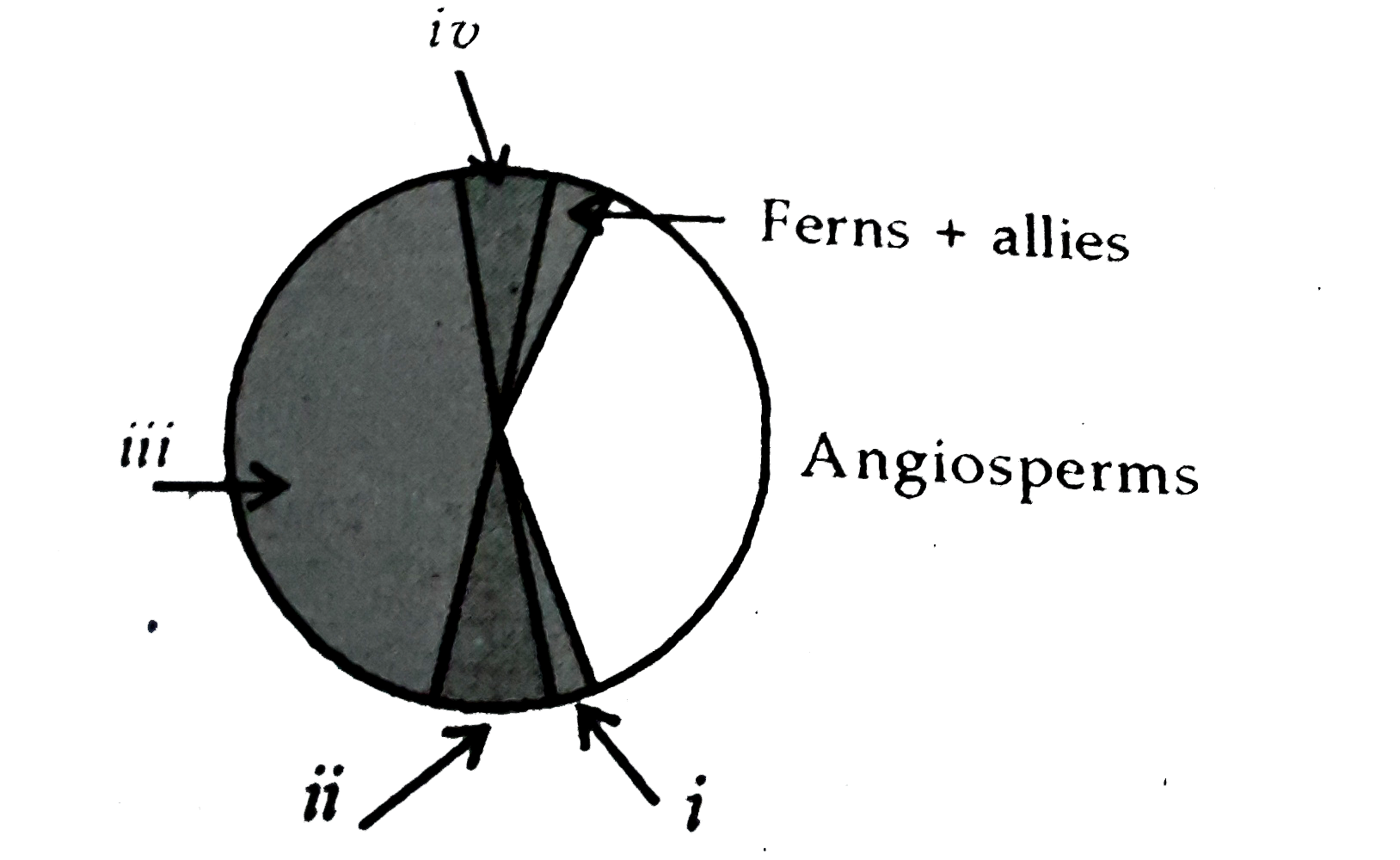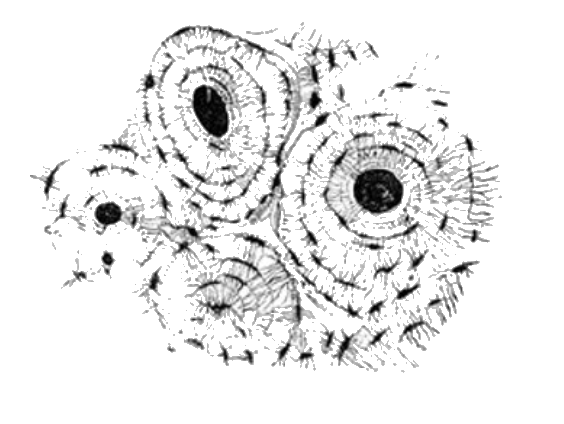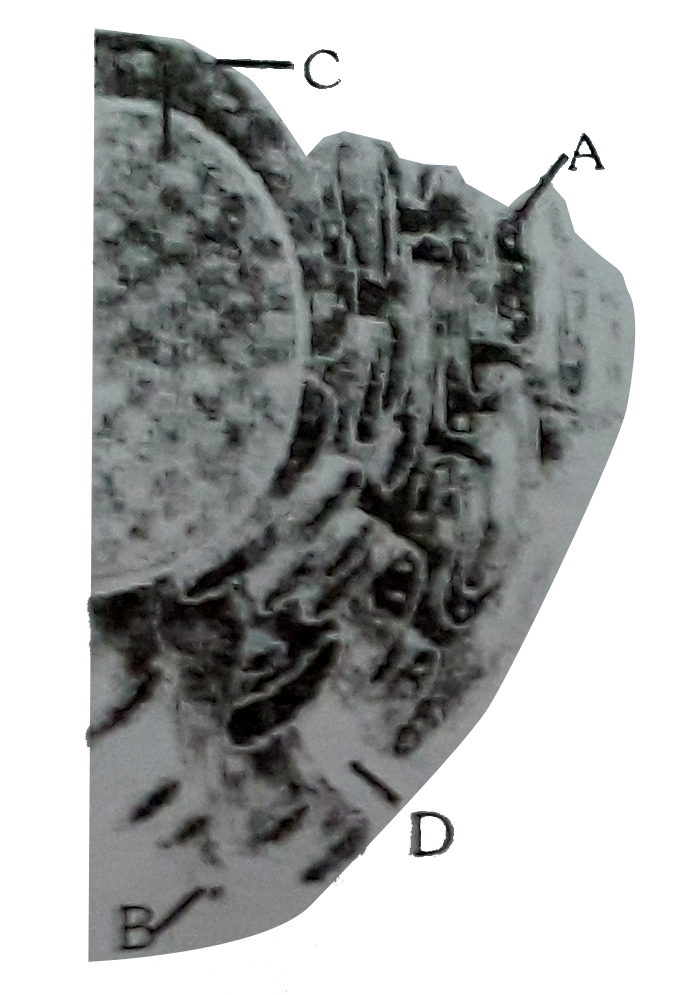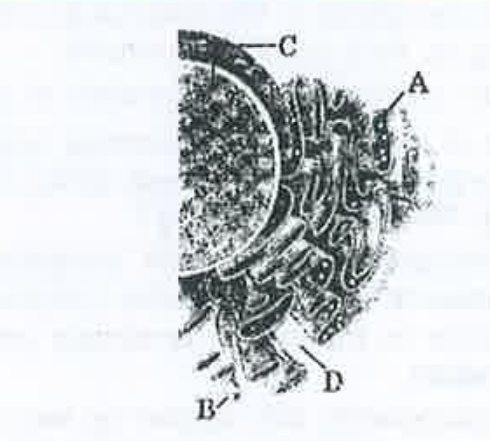Identify the correct sequence of plants in the order of character
given below
(i) Sporophyte with foot, intercalary meristem and capsule
(ii) Gemma cups on thallus
(iii) Sorus covered by false indusium
(iv) Embryophytic, tracheophytic, archegoniate
Anthoceros, Marchantia, Pteris, Ginkgo
Polytrichum, Lycopodium, Equisetum, Cedrus
Sphagnum, Selaginella, Psilotum, Ginkgo
Funaria, Gnetum, Dryopteris, Sequoia.
The correct Answer is:A
To solve the question regarding the correct sequence of plants based on the given characteristics, we will analyze each characteristic step by step and identify the corresponding plant group.
1. Identify the first characteristic: Sporophyte with foot, intercalary meristem, and capsule.
- The sporophyte structure is a key feature of bryophytes, particularly in the group called hornworts (Anthoceros). In hornworts, the sporophyte is differentiated into three parts: the foot, the seta (stalk), and the capsule. Additionally, hornworts possess intercalary meristem, which is unique among bryophytes.
- Conclusion: This characteristic corresponds to Anthoceros.
2. Identify the second characteristic: Gemma cups on thallus.
- Gemma cups are structures used for vegetative reproduction, and they are typically found in liverworts (Marchantia). Liverworts have a thalloid body structure where these gemma cups are located.
- Conclusion: This characteristic corresponds to Marchantia.
3. Identify the third characteristic: Sorus covered by false indusium.
- A sorus is a cluster of sporangia, and in ferns, the sorus can be covered by a structure called indusium. In some ferns, such as those in the genus *Tectaria*, the indusium is considered false because it arises from the upper side of the pinna (leaf).
- Conclusion: This characteristic corresponds to Tectaria.
4. Identify the fourth characteristic: Embryophytic, tracheophytic, archegoniate.
- The terms embryophytic and tracheophytic indicate the presence of vascular tissue and the retention of the embryo. Ginkgo (Ginkgo biloba) is a well-known example of a plant that is both embryophytic (retains the embryo) and tracheophytic (has vascular tissues). It also produces archegonia (female reproductive structures).
- Conclusion: This characteristic corresponds to Ginkgo.
Final Sequence:
Based on the analysis of each characteristic, the correct sequence of plants is:
1. Anthoceros (Sporophyte with foot, intercalary meristem, and capsule)
2. Marchantia (Gemma cups on thallus)
3. Tectaria (Sorus covered by false indusium)
4. Ginkgo (Embryophytic, tracheophytic, archegoniate)
Answer:
The correct sequence of plants in the order of the given characters is:
Anthoceros, Marchantia, Tectaria, Ginkgo.
---
- The sporophyte structure is a key feature of bryophytes, particularly in the group called hornworts (Anthoceros). In hornworts, the sporophyte is differentiated into three parts: the foot, the seta (stalk), and the capsule. Additionally, hornworts possess intercalary meristem, which is unique among bryophytes.
- Conclusion: This characteristic corresponds to Anthoceros.
- Gemma cups are structures used for vegetative reproduction, and they are typically found in liverworts (Marchantia). Liverworts have a thalloid body structure where these gemma cups are located.
- Conclusion: This characteristic corresponds to Marchantia.
- A sorus is a cluster of sporangia, and in ferns, the sorus can be covered by a structure called indusium. In some ferns, such as those in the genus *Tectaria*, the indusium is considered false because it arises from the upper side of the pinna (leaf).
- Conclusion: This characteristic corresponds to Tectaria.
- The terms embryophytic and tracheophytic indicate the presence of vascular tissue and the retention of the embryo. Ginkgo (Ginkgo biloba) is a well-known example of a plant that is both embryophytic (retains the embryo) and tracheophytic (has vascular tissues). It also produces archegonia (female reproductive structures).
- Conclusion: This characteristic corresponds to Ginkgo.
Based on the analysis of each characteristic, the correct sequence of plants is:
1. Anthoceros (Sporophyte with foot, intercalary meristem, and capsule)
2. Marchantia (Gemma cups on thallus)
3. Tectaria (Sorus covered by false indusium)
4. Ginkgo (Embryophytic, tracheophytic, archegoniate)
The correct sequence of plants in the order of the given characters is:
Anthoceros, Marchantia, Tectaria, Ginkgo.
Topper's Solved these Questions
- KINGDOM PLANTAE OR METAPHYTA BOOK - DINESH PUBLICATION ENGLISHCHAPTER - KINGDOM PLANTAE OR METAPHYTA EXERCISE - CYG
20 Videos
- KINGDOM MONERA (THE PROKARYOTES)BOOK - DINESH PUBLICATION ENGLISHCHAPTER - KINGDOM MONERA (THE PROKARYOTES)EXERCISE - CHECK YOUR GRASP
20 Videos
- KINGDOM PROTISTA (UNICELLULAR EUKARYOTES)BOOK - DINESH PUBLICATION ENGLISHCHAPTER - KINGDOM PROTISTA (UNICELLULAR EUKARYOTES)EXERCISE - CHECK YOUR GRASP
19 Videos
Similar Questions
Identfy the correct sequence of plants in the order of characters gives below I. Oveles borne along the ventral suture of unilocular overy II. Overes develop all around the inner surface of septa in a multilocular overy III. Overes borne on the inner walls of overy with false septum/septa
View SolutionThe correct order of increase in the size of the structures listed below is
(i) Proteins
(ii) Plant cell
(iii) Mitochondria
(iv) Ribosomes
View Solution
Knowledge Check
Complete the following paragraph by selecting the corrects sequence of words from the options given below The Neanderthal man with a brain size of I lived near East and Central ii between iii years back. They used iv to protect their body and buried theri dead.
A(i)(ii)(iii)(iv)500c.c.Australia2,00,000-1,40,000ClothesB(i)(ii)(iii)(iv)500c.c.Africa40,000-8,000twigsC(i)(ii)(iii)(iv)1400c.c.Asia1,00,000-40,000hidesD(i)(ii)(iii)(iv)650c.c.Africa75,000-10,000leavesGiven below are the steps of protein synthesis. Arrange them in correct sequence and select the correct option.
(i) Codon- anticodon reaction between mRNA and aminoacyl tRNA complex.
(ii) Attachment of mRNA and smaller sub-unit of ribosome.
(iii) Charging or aminoacylation of tRNA .
(iv) Attachment of larger sub-unit of ribosome to the mRNA-tRNA _(Met) complex.
(v) Linking of adjacent amino acids.
(vi) Formation of polypeptide chain.A(ii)→(i)→(iii)→(v)→(iv)→(vi)B(v)→(ii)→(i)→(iii)→(iv)→(vi)C(iii)→(ii)→(iv)→(i)→(v)→(vi)D(iii)→(ii)→(i)→(iv)→(v)→(vi)
Identify the correct sequence of steps in RNA-interference (RNAi) process to develop nematode resistant plants
(i) Silencing of specific mRNA of the nematode
(ii) Formation of sense and antisense RNA
(iii) dsRNA formation
(iv) Introducing nematode specific genes into plant
View SolutionIdentify the areas labelled (i), (ii), (iii) and (iv) in the pie chart given below representing the biodiversity of plants showing their proportionate number of species of major taxa.

View SolutionGiven below is the diagrammatic sketch of a connective tissue . Identify the correct statement/s in relation to it :

(i) it possesses a hard and non-flexible matrix.
(ii) Matrix is filled with yellow elastin fibre .
(iii) specialized cell related to this tissue are
(iv) Repair capabilities are high.
View SolutionIdentify the components labelled A, B, C and D in the diagram below from the list (i) to (vii) given along with
Components :
(i) Cristae of mitochondria
(ii) Inner membrane of mitochondria
(iii) Cytoplasm
(iv) Smooth endoplasmic reticulum
(v) Rough endoplasmic
(vi) Mitochondrial matrix
(vii) Cell vacuole
(viii) Nucleus
The correct components are

View SolutionIdentify the components labelled A, B, C and D in the diagram below from the list (i) to (viii) given along with

Components :
(i) Cristae of mitochondria
(ii) Inner membrane of mitochondria
(iii) Cytoplasm
(iv) Smooth endoplasmic reticulum
(v) Rough endoplasmic reticulum
(vi) Mitochondrial matrix
(vii) Cell vacuole
(viii) Nucleus
The correct components are
View SolutionIdentify the correct pair of characters in physalis I. Petiole adnate to stem. II. Thalamus cup-shaped. III. Seeds non-endospermic. IV. Flowers hypogynous.
View Solution
